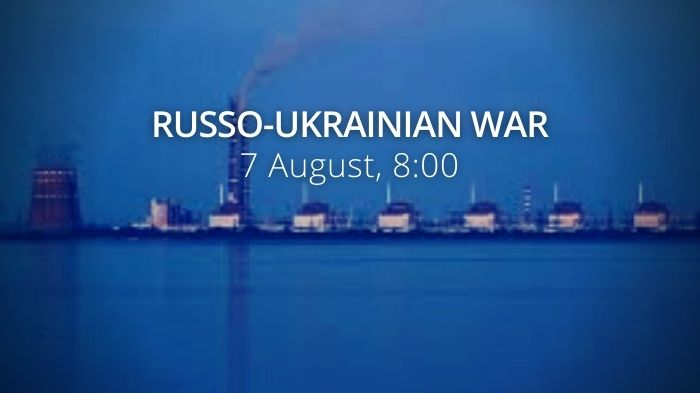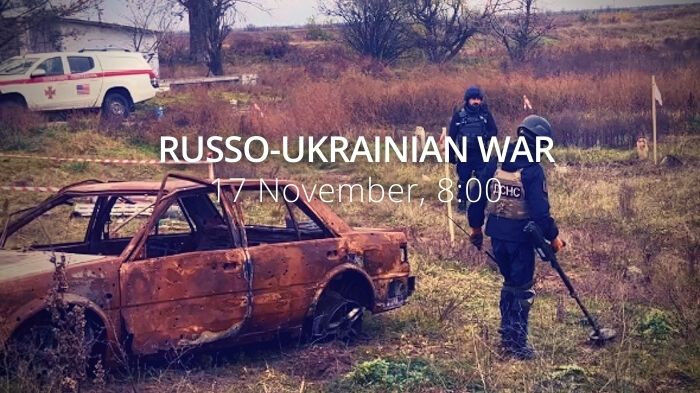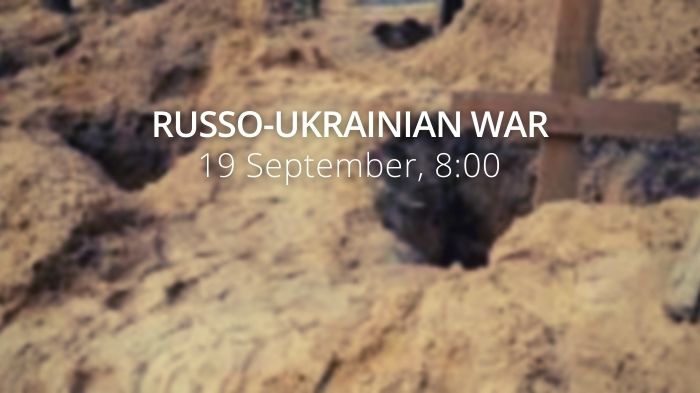NATO summit adopts decision concerning Ukraine: package of three elements. Ukrainian pilots’ F-16 training to start in August. France will provide Ukraine with long-range missiles and has already started supplying SCALP missiles to Ukraine.
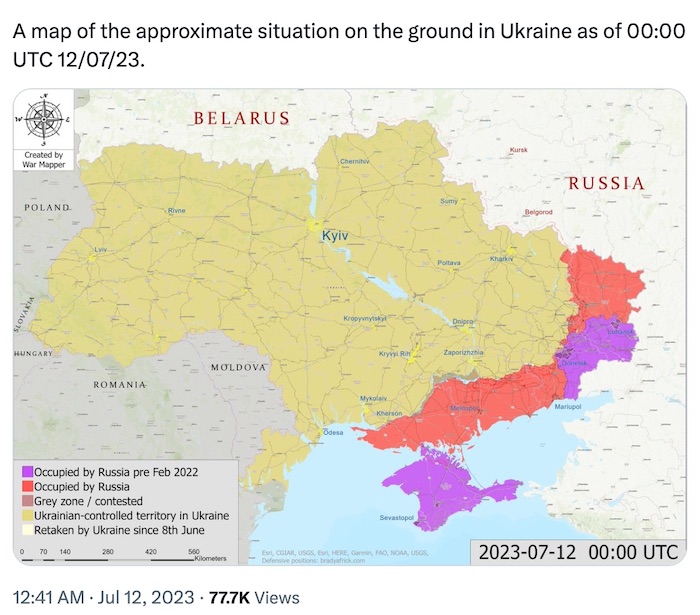
Daily overview — Summary report, July 12

The General Staff’s operational update regarding the Russian invasion as of 18.00 pm, July 12, 2023 is in the dropdown menu below:
Last night, the Russian Federation launched yet another airstrike with Iranian Shahed combat UAVs in Ukraine. Information on the aftermath of this terrorist attack is currently being updated.
On July 11, the Russian occupiers attacked Ukraine with Shahed combat UAVs. A total of 28 kamikaze drones were used. As a result of successful combat operations, the Ukrainian air defence intercepted 26 combat UAVs. Also, the Ukrainian defenders intercepted 5 operational-tactical level reconnaissance UAVs of the enemy.
On July 11, the enemy launched 65 airstrikes and 71 MLRS attacks at the positions of Ukrainian troops and various settlements. Unfortunately, the attacks caused civilian casualties on top of the destroyed infrastructure.
The likelihood of missile and air strikes across Ukraine remains high.
The adversary continues to focus its main efforts on Kupiansk, Lyman, Bakhmut, Avdiivka, and Marinka axes, and heavy fighting continues. On July 11, there were 29 combat engagements.
- Volyn and Polissya axes: no significant changes. No signs of the formation of an offensive group. Certain units of the armed forces of the Republic of Belarus continue their missions in the areas bordering Ukraine.
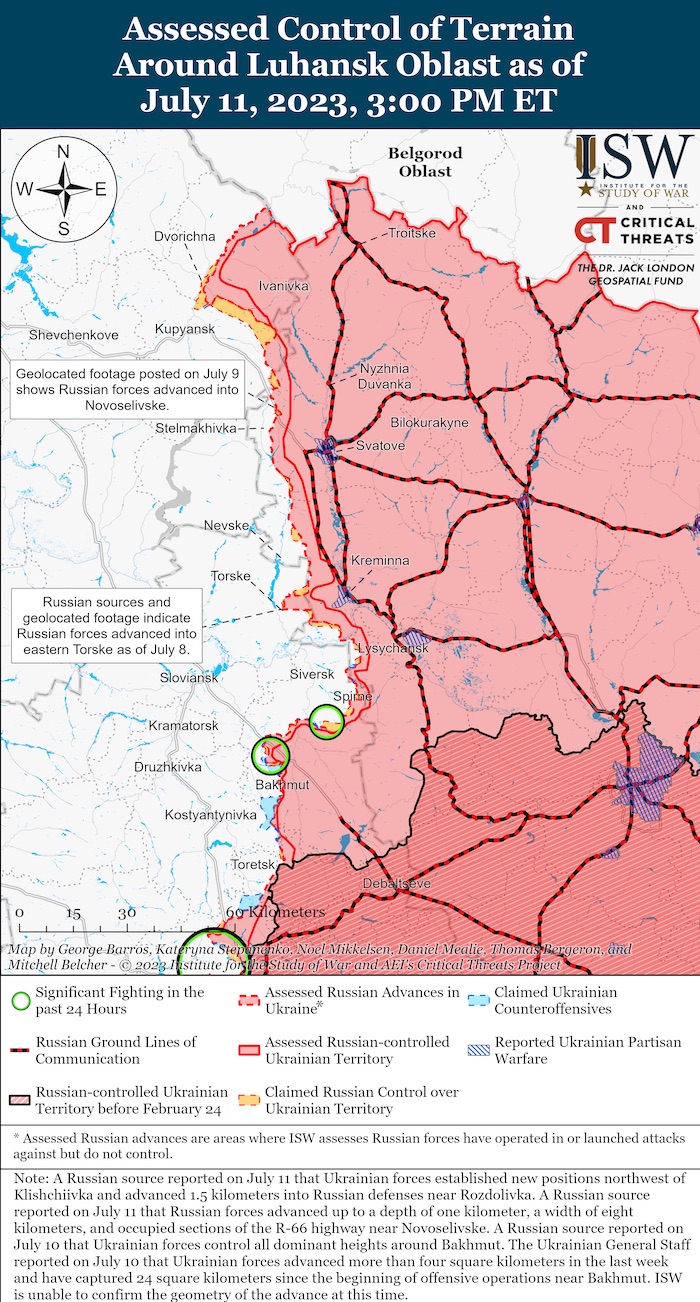
- Sivershchyna and Slobozhanshchyna axes: the adversary continues to maintain its military presence. On July 11, the invaders launched airstrikes in the vicinities of Volfyne (Sumy oblast) and Veterynarne (Kharkiv oblast). The adversary fired mortars and artillery at more than 20 settlements, including Karpovychi, Mykolaivka (Chernihiv oblast), Sopych, Romashkove (Sumy oblast), Strilecha, Veterynarne, Stroivka, and Sotnyts’kyi Kozachok (Kharkiv oblast).
- Kupiansk axis: the Ukrainian troops are standing their ground. The enemy launched airstrikes near Podoly, Kucherivka, and Kyslivka (Kharkiv oblast). Krasne Pershe, Kam’yanka, Dvorichna, Zapadne, Masyutivka, Kyslivka (Kharkiv oblast), and Novoselivs’ke (Luhansk oblast) came under artillery and mortar fire.
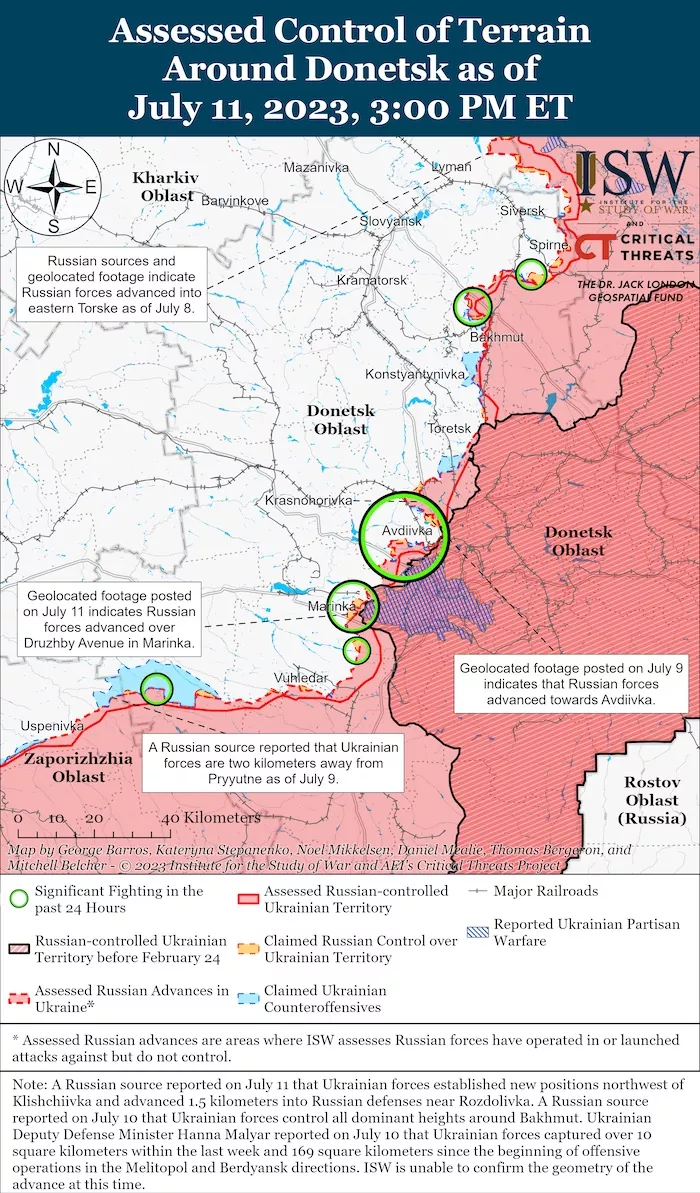
- Lyman axis: On July 11, the adversary conducted unsuccessful offensives in the vicinity of Vesele (Donetsk oblast). The enemy launched airstrikes in the vicinities of the settlements of Bilohorivka and Nevs’ke (Luhansk oblast). Nevske, Bilohorivka (Luhansk oblast), Rozdolivka, Tors’ke, Verkhn’okam’yans’ke, and Vesele (Donetsk oblast) were shelled with artillery.

- Bakhmut axis: under heavy fire from enemy aircraft and artillery, the Ukrainian defenders successfully repelled enemy attacks in the vicinity of Hryhorivka and east of Orikhovo-Vasylivka. More than 15 settlements, including Oleksandro-Shul’tyne, Vasyukivka, Bohdanivka, Khromove, Chasiv Yar, Pivdenne, and Ivanivske (Donetsk oblast), suffered from enemy artillery shelling.
- Avdiivka axis: the Ukrainian Defence Forces continue to hold back the Russian offensive in the vicinities of Avdiivka, Pervomaiske, and Nevelske. The enemy launched airstrikes near New York and the city of Avdiivka. At the same time, the occupiers fired artillery at more than 10 settlements, including Avdiivka, Berdychi, Sjeverne, and Nevel’s’ke (Donetsk oblast).
- Marinka axis: under enemy artillery fire, Ukrainian defenders repelled all attacks in the vicinities of settlements of Pobjeda, Novomykhailivka, and Mar’inka. The enemy shelled more than 15 settlements, including Kostyantynivka, Mar’inka, Pobjeda, and Yelyzavetivka (Donetsk oblast).
- Shakhtarske axis: the adversary conducted unsuccessful offensive operations in the vicinity of Blahodatne. The invaders launched airstrikes near Odradne, Storozheve, Rivnopil’, and Makarivka. The enemy shelled more than 15 settlements, including Vuhledar, Blahodatne, Makarivka, and Prechystivka (Donetsk oblast).
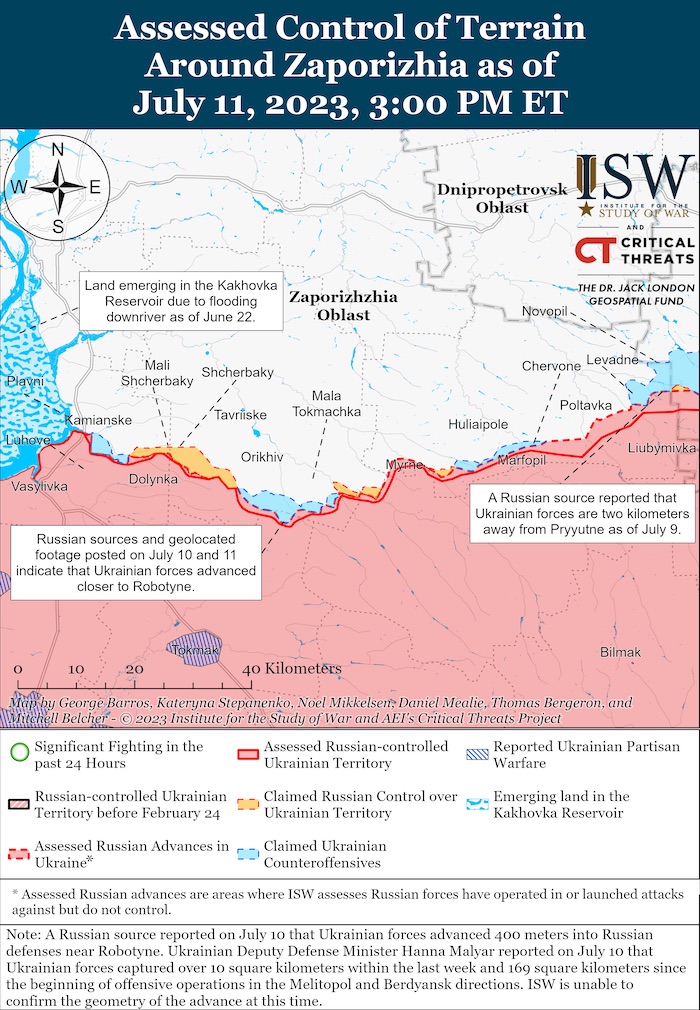
- Zaporizhzhia and Kherson axes: the adversary focuses its main efforts on preventing the further advance of Ukrainian troops. The enemy launched airstrikes in the vicinities of settlements of Mala Tokmachka, Orikhiv (Zaporizhzhia oblast), Zolota Balka, and Molodizhne (Kherson oblast). The adversary fired artillery at more than 30 settlements, including Hulyaipole, Huliaipilske, Zaliznychne, Poltavka, Ol’hivs’ke (Zaporizhzhia oblast), Kozats’ke, L’vove, Inzhenerne, Tokarivka (Kherson oblast), the city of Kherson, Dniprovs’ke, Dmytrivka, and Ivanivka (Mykolaiv oblast). At the same time, the Ukrainian Defense Forces continue to conduct offensive operations on Melitopol’ and Berdyans’k axes, consolidating their positions, and conducting counter-battery fire.

[Repression against citizens of Ukraine [is increasing] in Henichesk of the Kherson Oblast. According to the available information, getting “into the basement” has become many times easier, since local collaborators, wanting to serve themselves before the ROV, constantly slander citizens and conduct groundless inspections. The occupiers also threaten the local population that if they do not have a Russian passport, citizens will be forcibly deported to Siberia and all their property will be confiscated.]
On July 11, Ukrainian Air Force launched 15 air strikes on the concentrations of troops, weapons, and military equipment, as well as 4 air strikes on the anti-aircraft missile systems of the enemy.
On July 11, the Ukrainian missile and artillery troops hit 3 command posts, 10 artillery systems at their firing positions, 1 air defence asset, and 1 electronic warfare station of the adversary.“
Ukraine’s army liberates almost as much territory in 5 weeks as Russians captured in 6 months – ISW, Ukrainska Pravda reports, citing the Institute for the Study of War. “Analysts at the Institute for the Study of War (ISW) estimated that Ukraine’s Armed Forces liberated as much territory in five weeks of counteroffensive as the Russians captured in half a year. According to the report, on 10 July, Russian ground communication lines and Bakhmut are under the fire control of the Ukrainian forces. […]
Based on its own array of geographical data, ISW has determined that since the start of the Ukrainian counteroffensive on 4 June, Ukrainian forces have reclaimed about 253 square kilometres of land. The review clarifies that Ukrainian data differ from ISW data due to different approaches to calculations. In comparison, since 1 January, Russian troops have captured a total of 282 square kilometres of Ukrainian territory.
Military Updates
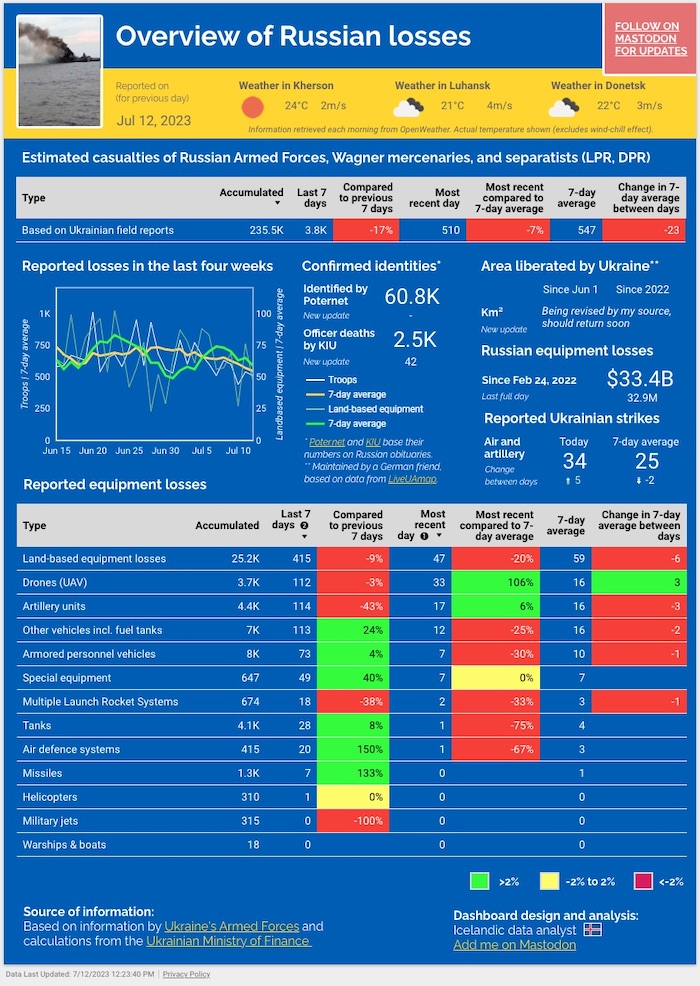
On July 10, 2 companies of occupants, 14 pieces of equipment and 7 warehouses were destroyed in Tavria direction, Censor.net reports, citing the commander of the Tavria operational and strategic group of the Armed Forces of Ukraine, Oleksandr Tarnavskyi. “Over the last day, the enemy attacked our positions 27 times and made 668 attacks. Artillery units of the Ukrainian Defence Forces in the Tauride sector carried out 1418 firing missions over the last day. Enemy losses in killed and wounded amounted to almost two companies. 14 units of enemy military equipment were destroyed.
In particular, 6 armoured personnel carriers, MTLBs, 2S19 Msta-S howitzer, 2A65 Msta-B howitzer, 2A36 Hyacinth-B cannon and vehicles. Seven enemy ammunition depots were also destroyed.”
Hotel housing Russian military commanders destroyed in Berdiansk, Ukrainska Pravda reports, citing the press service of the Berdiansk City Military Administration. “[There has been – ed.] a strike on the Duna hotel, where the military command of the occupiers was lodged. Reportedly, the building has essentially been razed to the ground, the debris is being removed. Ambulances were sent to the site of the strike. The military administration advises to wait for the official information from the General Staff of the Armed Forces of Ukraine.
Later, the military administration reported that the residents of Berdianks heard another explosion at 14:00.”
Russian general Tsokov was eliminated in Berdiansk, – Andriushchenko, Censor.net reports, citing Petro Andriushchenko, adviser to the mayor of Mariupol. “It is reported that today in the Berdiansk district, the Russian lieutenant-general Oleg Yuriyovych Tsokov was eliminated, the message reads.”
In occupied Novooleksiivka, warehouse of Russian ammunition was destroyed, – Fedorov, Censor.net reports. “In the temporarily occupied Novooleksiivka of the Kherson region, a warehouse of enemy ammunition, which was located on a local elevator, was destroyed. This was reported by the Mayor of Melitopol, Ivan Fedorov.”
Commander involved in strikes on Ukraine shot dead in Russia, Ukrainska Pravda reports, citing Russian RBC. “Stanislav Rzhytsky, deputy head of the department for mobilisation, was shot dead in the city of Krasnodar, Russia. […] Anonymous pro-Russian Telegram channels have reported that 42-year-old Stanislav Rzhytsky went for a run at eight o’clock in the morning. He was ambushed near the Olimp sports complex by an unknown person who shot Rzhytsky four times in the back and chest and then fled the scene. The victim died on the spot from his injuries.
In July 2022 Our Money.Lviv journalists shared an investigation which uncovered the names of commanders of submarines of the Russian Federation’s Black Sea division, including Captain 2nd rank Stanislav Rzhytsky, who commanded the Krasnodar submarine, according to the data from 2019-2021. Rzhytsky might have been involved in the Kalibr missile strike on Vinnytsia in July 2022, which killed at least 27 civilians.”
Ukraine’s Defence Intelligence confirms assassination of Russian commander involved in attacks on Ukraine, Ukrainska Pravda reports, citing Press service of the DIU. “Defence Intelligence of Ukraine (DIU) has confirmed that Stanislav Rzhitskiy, the former commander of the Krasnodar submarine of the Russian Black Sea Fleet, involved in missile attacks on Ukraine, has been shot dead in the Russian city of Krasnodar.”
UAV attack on the night of July 12, the Ukrainian General Staff reports. “On the night of July 12, 2023, the Russian occupiers attacked Ukraine from the north-eastern direction (Kursk) with Iranian-made Shahed-type attack drones. A total of 15 kamikaze drones were involved in the strike. 11 of them were destroyed in the areas of responsibility of the “Center” and “East” air commands.
During the current and past days, the Air Force of the Armed Forces of Ukraine carried out almost 30 group airstrikes against the enemy’s rear, military equipment, positions and accumulation of manpower.”
UAV attack on the night of July 11, the Ukrainian General Staff reports. “On the night of July 11, 2023, the Russian occupiers attacked Ukraine from the south-eastern direction (Prymorsko-Akhtarsk) with Iranian-made attack drones of the “Shahed” type. A total of 28 kamikaze drones were involved.
As a result of successful combat operations in the area of responsibility of the “South” air command, the forces and means of the Air Force, in cooperation with the air defence of other components of the Defence Forces, destroyed 26 attack UAVs and one reconnaissance drone of the “Zala” type.
In addition, over the past day, on July 10, the Air Force destroyed an enemy helicopter (type to be specified), three attack UAVs of the Lancet type and four operational-tactical reconnaissance drones.”
According to British Defence Intelligence, (last 48 hours):
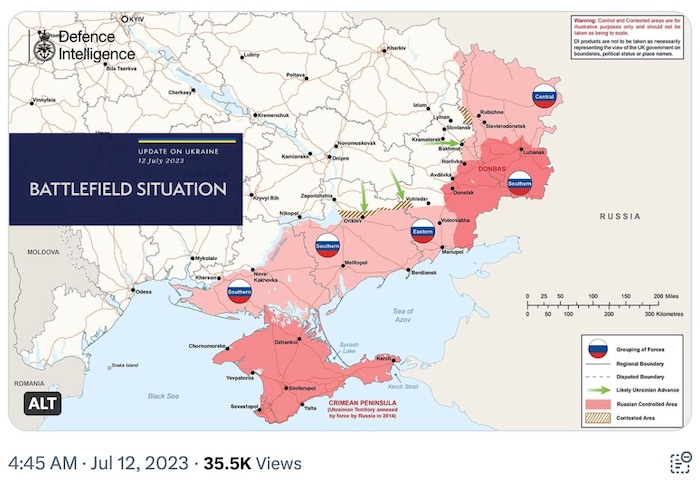
- On 10 July 2023, Russian Chief of the General Staff General Valery Gerasimov made his first TV appearance since the abortive Wagner mutiny of 24 June 2023.
- Gerasimov was seen being briefed by video link by Russian Aerospace Forces Chief of Staff Colonel-General Viktor Afzalov. Afzalov has been in post for at least four years, but this is probably his first public appearance with Gerasimov.
- Afzalov is deputy to Commander-in-Chief Russian Aerospace Forces, General Sergei Surovikin. Afzalov’s increased public profile, while Surovikin’s whereabouts remains unclear, adds further weight to the hypothesis that Surovikin has been sidelined following the mutiny.
- Moscow’s municipal authorities are highly likely threatening to withdraw contracts from construction firms if they fail to hit quotas for providing ‘volunteers’ to serve in Ukraine. One company has reportedly been set a target of 30 volunteers by the end of August 2023.
- The move will likely primarily affect ethnic minorities from poorer regions of Russia such as Dagestan and central Asian states, who make up the majority of Moscow’s construction workers.
- This measure is highly likely at least tacitly endorsed by Moscow mayor Sergey Sobyanin. It continues his track record of trying to minimise the impact of the conflict on better-off Muscovites, while still being seen to support the war effort.
Losses of the Russian army
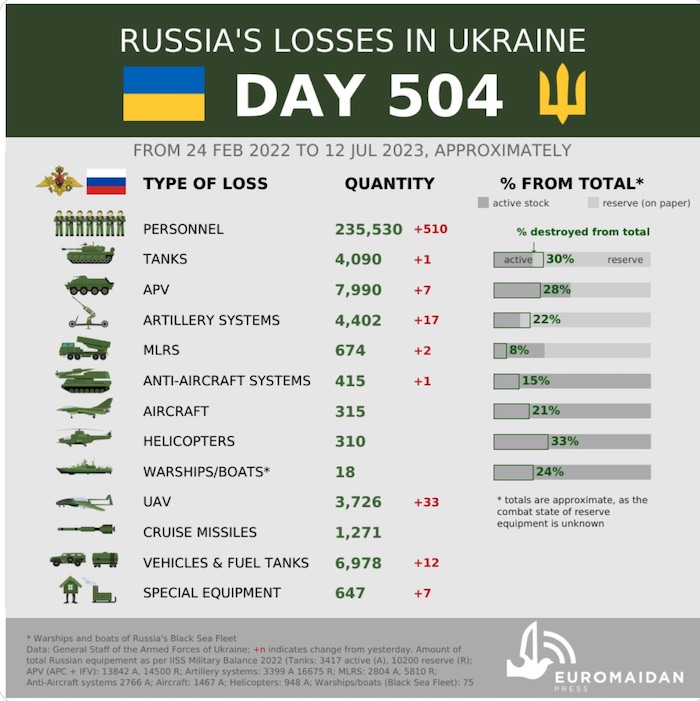
As of Wednesday 12 July, the approximate losses of weapons and military equipment of the Russian Armed Forces from the beginning of the invasion to the present day:
- Personnel – about 235530 (+510)
- Tanks – 4090 (+1)
- Armoured combat vehicles – 7990 (+7)
- Artillery systems – 4402 (+17)
- Multiple rocket launchers –MLRS – 674 (+2)
- Air defence means – 415 (+1)
- Aircraft – 315 (+0)
- Helicopters – 310 (+0)
- Automotive technology and fuel tanks – 6978 (+12)
- Vessels/boats – 18 (+0)
- UAV operational and tactical level – 3726 (+33)
- Special equipment – 647 (+7)
- Mobile SRBM system – 4 (+0)
- Cruise missiles – 1271 (+0)
Belarusian officials claim Wagner mercenaries will train Belarusians to fight, Ukrainska Pravda reports, citing Belarusian state-owned news agency BelTA with reference to the country’s Ministry of Defence. “After the arrival of representatives of the Wagner PMC and their dispersal at the training grounds for classes and mutual exchange of experience, special attention will be paid to the methods and means of warfare by the Armed Forces of Belarus.
The Ministry of Defence said that the training grounds of Belarus are completing the preparation and combat coordination of the next set of units of the Russian Armed Forces from the regional grouping of troops. The training grounds of the Armed Forces of Belarus are preparing to take another shift for the joint training of military personnel of Belarus and Russia. The previous rotation of the Russian regional grouping of troops, which took place more than a month ago, was successfully completed.
In the event of threats to the Union State, the units of the regional grouping of troops are ready to provide security and protection, the Russian Defence Ministry added.”
Increasing number of Russians surrender on Tavriia front, Ukrainska Pravda reports, citing Valerii Shershen, spokesman for the Joint Press Centre of the Tavriia Defence Forces. “Enemy losses of killed, wounded and captured [troops] are very significant… Over the past 24 hours, we recorded 19 surrenders [in the previous 24 hours there were 10 prisoners – ed.] This is the first time such a large number of prisoners has been recorded specifically in the summer and specifically during the Tavriia group’s offensive operations.
This is indicative of low morale and demotivation among enemy personnel. And, of course, that is a success on our side.”
Humanitarian
Expert: Russia’s “tricks” within grain deal fail, Ukrinform reports, citing Pavlo Lakiychuk, head of security projects at the Center for Global Studies, Strategy 21, on the air of Ukrainian Radio. “According to him, if Russia withdraws from the agreement, the transit of maritime traffic to Ukrainian ports should be guaranteed by the Turkish Navy or other states, which both the Turkish side and the UN are ready to involve in this operation. They may decide to use a peacekeeping contingent, for example, from NATO’s standing operational force in the Mediterranean, Lakiychuk stated.
In his opinion, the Turkish Navy is much more powerful than the Russian one. So, Ankara has every opportunity to ensure peace in the Black Sea while transporting Ukrainian grain to Africa and Asia. The Turkish Navy has become very strong over the past 30 years. Now, although Türkiye does not concentrate warships on a permanent basis in the Black Sea, they have a powerful navy that far exceeds the capabilities of the Russian Black Sea Fleet, the expert said.
In his words, the main Turkish naval base is in Gölcük, in the Gulf of İzmir, almost near the Bosphorus. Ships from Gölcük can enter the Black Sea at any time, it will take an hour, 2-3 at most, and they will be there. […] On the other hand, the Turkish side controls the Black Sea straits based on the Montreux Convention Regarding the Regime of the Straits. Here a lot depends on Türkiye if the UN or any other international organization decides to engage other countries’ navies to escort Black Sea Grain Initiative ships, the expert noted.
In his opinion, it is unlikely that Russians will dare to attack civilian vessels flying non-Ukrainian flags in neutral waters, as this would mean the conflict would spread to those players that Russia did not intend to face. If Türkiye provides guarantees for the grain corridor, it will be a tough step. Türkiye knows how to act tough, including against Russia, the expert emphasized. In this regard, he recalled the situation in Syria in 2018, when the Turkish military shot down a Russian bomber. It was a signal to Putin, and he understood it. […]
As reported, the grain agreement was signed in July last year with the participation of Ukraine, Türkiye, and the UN, as well as separately by Türkiye, the UN, and Russia. The agreement guarantees the safe passage of ships carrying Ukrainian grain. Its observance is ensured by the Joint Coordination Center in Istanbul, which includes representatives of all parties. Russia threatens to withdraw from the grain deal if it fails to resume pumping ammonia through the Tolyatti-Odesa pipeline and partially lift restrictions on its exports.
Ukrainian government has stated that the Russian side is actually blocking the grain initiative. Russia openly sabotages ship inspections. This has reduced the grain corridor’s capacity to less than 20% of its potential. Russia confirmed its participation in the agreement at the end of May, extending it for 60 days, until July 17.”
Environmental
Russia needs to withdraw troops from Zaporizhzhia NPP – NATO Secretary General, Ukrinform reports. “Russia needs to withdraw its military forces from Zaporizhzhia NPP, its behaviour threatens the safety of the plant. NATO Secretary General Jens Stoltenberg said this to journalists before the start of the NATO Summit in Vilnius. On the situation in Zaporizhzhia (Zaporizhzhia nuclear power plant – ed.) our message to Russia is that they need to withdraw their forces. Because the way they now behave in Zaporizhzhia is undermining the security of this biggest nuclear power plant in Europe, Stoltenberg commented on how NATO would respond in the event of a nuclear accident at the occupied ZNPP.
The NATO Secretary General also commented on Russia’s nuclear rhetoric, calling it dangerous and reckless. Russia must know that nuclear war can never be won and never been fought. NATO allies, of course, monitoring closely what Russia is doing. We condemn the announcement that Russia will deploy tactical nuclear weapons to Belarus. We are monitoring closely what they are doing, he said.”
Legal
Bulgarian PM about cluster munitions for Ukraine: Success on battlefield more important than treaties, Ukrinform reports, citing Sky News. “Bulgarian Prime Minister Nikolai Denkov said he did not want to delve into the issue of the United States providing cluster munitions to Ukraine, emphasizing that Kyiv’s successes on the battlefield are more important than the signed treaties. In particular, speaking about the US decision to provide Kyiv with cluster munitions, the Bulgarian Prime Minister noted that we’re in a full-fledged war.
So when you have a war the treaties are important, but it’s even more important to have success on the battlefield, Denkov emphasized. Denkov added that decisions on cluster munitions are politically sensitive but said he did not want to go “deeper into the topic”.
Bulgaria is one of 123 countries that have signed a convention banning the use of cluster munitions. As Ukrinform reported, on Friday, July 7, the United States announced it would supply Ukraine with cluster munitions to help the Ukrainian Armed Forces in a counteroffensive. The use of these weapons is controversial, primarily because a certain percentage of explosive devices do not detonate but remain on the ground and pose a serious threat to the population even many years after the end of hostilities. In this regard, Washington has assured that the percentage of munitions they transfer to Ukraine does not exceed 2.5%, compared to 30-40% of those used by Russian troops in Ukraine. The United States, Ukraine and Russia have not signed a treaty banning cluster munitions, the so-called Oslo Convention.”
Support
Ukrainian pilots’ F-16 training to start in August, officials say, Reuters reports. “A coalition of 11 nations will start training Ukrainian pilots to fly F-16 fighter jets in August in Denmark, and a training centre will be set up in Romania, officials said on Tuesday on the sidelines of a NATO summit in Lithuania. NATO members Denmark and the Netherlands have been leading international efforts to train pilots as well as support staff, maintain aircraft and ultimately enable the supply of F-16s to Ukraine in its war with Russia.
Hopefully, we will be able to see results in the beginning of next year, Denmark’s acting defence minister Troels Lund Poulsen told reporters following a signing ceremony. So far, no countries have committed to sending F-16s to Ukraine, though Poland and Slovakia have supplied 27 MiG-29s to supplement Ukraine’s fleet of combat aircraft.”
France will provide Ukraine with long-range missiles, Ukrainska Pravda reports, citing European Pravda, referring to French President Emmanuel Macron’s statement in Vilnius. “In a conversation with journalists, Macron announced the decision to transfer long-range missiles to Ukraine without mentioning the name.
We have decided to provide Ukraine with new missiles that will allow it to attack deep [behind Russian lines – ed.]. They will be applied under our agreements, Macron said.»
France has already started supplying SCALP missiles to Ukraine, Censor.net reports, citing Reuters. “Paris received an assurance from Kyiv that the missile would not be launched on the territory of Russia. According to the interlocutor of the publication, it is about 50 SCALP missiles. A second source familiar with the situation said that some missiles have already been delivered to Ukraine.
SCALP missiles are similar to the British Storm Shadow, they have a range of about 250 kilometers.”
Germany confirms refusal to provide Taurus missiles to Ukraine, Ukrainska Pravda reports, citing Boris Pistorius on the sidelines of the NATO summit in Vilnius and Tagesspiegel. “German Defence Minister Boris Pistorius has confirmed the German government’s refusal to supply Ukraine with Taurus long-range cruise missiles. […]
At the end of May, Ukraine requested the German government to provide it with Taurus cruise missiles with a range of up to 500 kilometres, but the position of the German authorities “remains reserved.”
Germany provides Ukraine with what is now priority – German Minister of Defence, Ukrainska Pravda reports, citing European Pravda. “During the NATO summit in Vilnius, Pistorius said the new aid package comprises Ukraine’s main priorities: air defence, tanks, artillery. Thus, we make an important contribution to strengthening Ukraine’s ability to survive [in the war with Russia – ed.].
The Ministry of Defence stated that Kyiv will receive 2 launchers for the Patriot air defence system, 40 Marder infantry fighting vehicles, 25 Leopard 1 tanks, and 1 Luna unmanned aerial vehicle system.
Earlier it was reported that Berlin’s new package of military assistance for Kyiv will include air defence, infantry fighting vehicles, shells and drones worth about €600 million. Meanwhile, dpa, citing its sources, reports that the cost of the package is even greater – almost €700 million.”
UK to provide Ukraine with ammo, vehicles and $65 mln for equipment repair, Reuters reports. “The British government said on Tuesday it will provide Ukraine with more than 70 combat and logistic vehicles, thousands of rounds of ammunition for Challenger 2 tanks, and a 50 million pound ($64.7 million) support package for equipment repair.
Britain also said that all Group of Seven (G7) members – Canada, France, Germany, Italy, Japan and United States – were expected to sign a new framework on Wednesday that would provide long-term, bilateral security commitments for Ukraine, that would be detailed in due course.”
Ukraine’s Delta system passes NATO tests and can integrate F-16s, Ukrainska Pravda reports, citing Mykhailo Fedorov, Deputy Prime Minister for Innovation, Minister of Digital Transformation of Ukraine. “The Ukrainian combat control and information processing system Delta has successfully passed NATO tests, including for interoperability with F-16 fighter jets. […]
Four data exchange protocols were also tested, which indicate that most of the modern weapons Ukraine receives from Western partners work. The main protocol is the Link 16 network, which makes it possible to receive data in Delta from F-16 fighter jets, as Fedorov explained.
Delta enables soldiers to see the battlefield online, with the location of Russian forces. This is the only platform in Ukraine that pulls data from aerial reconnaissance, satellites, drones, the latest equipment, stationary cameras, radars, chatbots, etc. All this data allows for better planning of military operations.”
NATO summit adopts decision concerning Ukraine: package of three elements, Ukrainska Pravda reports, citing Jens Stoltenberg, NATO Secretary General, at the press conference following the first day of the summit, as reported by a correspondent of European Pravda. “Today the allies adopted a package consisting of three elements, which will bring Ukraine closer to NATO. The first element is a new durable support program for Ukraine, which will make the transition from the Soviet to NATO standards in training and doctrines possible.
The second element is creating the new Ukraine-NATO council, which will be a forum for consulting and making decisions, where Ukraine and NATO members will meet as equals, Stoltenberg explained. The third element – we have confirmed that Ukraine will become a member of NATO and agreed to waive the Membership Action Plan. This will make Ukraine’s accession a one-step process instead of a two-step one. We have also made it that we will announce about the invitation of Ukraine to NATO, when the allies agree, and the conditions are fulfilled.
On 10 July, Volodymyr Zelenskyy, President of Ukraine, harshly criticised the discussions about Ukraine’s potential path towards NATO, having written: Uncertainty is weakness.”
Estonian Prime Minister on NATO’s decision: This is as much as we can now offer Ukraine, Ukrainska Pravda reports, citing the Estonian broadcaster ERR. “Estonian Prime Minister Kaja Kallas has said that she understands the disappointment of the Ukrainian side with the decisions of the Vilnius NATO summit, but stressed that this topic is taken very seriously in the Alliance. The Estonian prime minister noted that disputes over the wording of the declaration of the NATO summit in Vilnius show that our Allies are also very serious about these words, that they are not just words, but that they too must actually translate these words into action.
Of course, I also understand President Zelenskyy’s frustration, because he wants to live in peace, just as we who are in NATO live in peace. But this is how much we can offer now, she added. Kallas explained that Ukraine could not now become a member of the Alliance because of its [NATO’s] fear of going to war with Russia. What we can do to end this war is support Ukraine so that they can organise their own defence so that they can really push the Russians back into their territory – that’s what we can do, she added. […]
The decision of the Vilnius summit contains quite positive wording regarding Ukraine. In particular, the NATO summit agreed to remove the requirement for an action plan for membership on Ukraine’s way to the Alliance. At the same time, the Allies made it clear that they would invite Ukraine to join NATO when the conditions are met.”
EU to provide security guarantees for Ukraine, Ukrainska Pravda reports, citing Politico. “The EU’s foreign policy body, the European External Action Service (EEAS), has developed a draft plan to provide Ukraine with “security obligations” that provide for constant military support and cooperation. Proposals of the EU foreign ministry on “security guarantees” for Ukraine, which currently have the status of recommendations, cover options ranging from sustainable arms supplies, continuing military exercises, sharing intelligence, to helping establish ties between Ukrainian and European defence companies.
A key element of such commitments is the creation of a special fund for long-term military support for Ukraine, which will be valid until 2027. European officials are due to announce the creation of such a fund soon. Under this fund, the EU will spend four billion euros by the end of the year to help Ukraine with weapons, and over time, it will develop to purchase more sophisticated and costly weapons systems, such as missiles and fighter jets.
The more we can talk about long-term engagements, the more we can send Putin the message that he cannot count on European fatigue, due to elections or whatever other reason, an EU diplomat told Politico. However, he added, this “doesn’t mean we [the EU. – ed.] are betting that the war will last.”
G-7 will adopt joint declaration on security guarantees for Ukraine, – Scholz, Censor.net reports, citing German Chancellor Olaf Scholz and DW. “G-7 countries will adopt a joint declaration on security guarantees for Ukraine after the war. It is important for us that there are security promises for Ukraine that can be effective after peace comes. And for this purpose, we will also conclude the necessary agreements now, in terms of what is needed in a peaceful situation…
The G7 countries will sign a joint declaration here, which will express this, and which will then be supported by individual countries in very specific terms, he said. According to Bloomberg, the declaration, which aims to provide Ukraine with long-term security guarantees, is still under discussion and the content and signatories may change before it is announced.”
New Developments
- Russia’s Lavrov: Ukraine conflict will not end until West drops plans to defeat Moscow, Reuters “The armed confrontation in Ukraine will continue until the West gives up plans to dominate and defeat Moscow, Russian Foreign Minister Sergei Lavrov said […]. Why doesn’t the armed confrontation in Ukraine come to an end? The answer is very simple – it will continue until the West gives up its plans to preserve its domination and overcome its obsessive desire to inflict on Russia a strategic defeat at the hands of its Kyiv puppets, according to a transcript of the interview published on Russia’s foreign ministry website. For the time being, there are no signs of change in this position.”
- NATO removed MAP from requirements for Ukraine regarding future membership, – Stoltenberg, net reports. “NATO Secretary General Jens Stoltenberg says the Allies have agreed to withdraw Ukraine’s implementation of the Membership Action Plan. He announced this at a press conference that took place after the meeting of the heads of state and government of NATO member countries. We have confirmed that Ukraine will be a member of NATO and agreed to remove the requirement for a Membership Action Plan. This will change Ukraine’s path to membership from a two-step process to a one-step process, Stoltenberg said. We also made it clear that we will send Ukraine an invitation to join NATO when the Allies agree and when the conditions allow,” said the Secretary General of the Alliance.”
- ‘Ukraine will make NATO stronger,’ Zelenskyy says in summit city, Reuters “President Volodymyr Zelenskyy voiced disappointment that Ukraine was not invited to join NATO on Tuesday, telling supporters in the Lithuanian capital: Is this too big of a wish? NATO will make Ukraine safer, Ukraine will make NATO stronger, he told the thousands of people, many waving Ukrainian flags, who gathered in central Vilnius, host to an alliance summit, as snipers stood guard on rooftops. He thanked Lithuania for a clear, honest and courageous position in support of Ukrainian membership.”
- Zelenskyy criticised partners who discuss NATO without Ukraine: unprecedented and absurd, Ukrainska Pravda reports, citing President Zelenskyy. “Ukraine will be represented in Vilnius at the NATO summit. Out of respect. But Ukraine also deserves consideration. Now, on the way to Vilnius,we have received signals that the wording without Ukraine is being discussed. And I want to emphasise that this wording is only about the invitation and not Ukraine’s membership. Unprecedented and absurd – when there is no time frame for the invitation and the membership of Ukraine, and when some strange wording is added about the ‘conditions’ even for the invitation of Ukraine… There seems to be no readiness to invite Ukraine to join NATO or make it a member of the Alliance. This means that Ukraine’s membership in NATO remains a possible bargain chip – in negotiations with Russia. And for Russia, this implies a motivation to continue its terror in the future.”
- Russia’s Medvedev: NATO’s military aid to Ukraine brings World War Three closer, Reuters “Dmitry Medvedev, the deputy secretary of Russia’s powerful Security Council chaired by President Vladimir Putin, said late on Tuesday that the increase in military assistance to Ukraine by the NATO alliance brings World War Three closer. Commenting on the first day of the summit of the US-led alliance in Lithuania, where a number of countries pledged more weaponryand financial support, Medvedev said the aid would not deter Russia from achieving its goals in Ukraine.”
- Ukraine is only country that uses NATO weapons and strategy in war against Russia, – head of Ministry of Foreign Affairs of Estonia Tsakhna, net reports, citing RBC-Ukraine. “The Minister of Foreign Affairs of Estonia, Margus Tsakhna, noted that there is no need for the Membership Action Plan, as Ukraine is already implementing it on the battlefield against the Russian invaders. To be honest, Ukraine is the only country that uses NATO weapons, ammunition, tactics, and strategy against Russia, Tsakhna said.”
- Sweden has taken ‘very big step’ towards NATO membership, prime minister says, Reuters “Sweden has taken a big step towards NATO membership after striking a deal with Turkish President Tayyip Erdogan to let Sweden into the alliance, Swedish Prime Minister Ulf Kristersson said on Monday.”
- Polish PM urges Ukraine to allow exhumation of all victims of WW2 massacres, Reuters “Poland and Ukraine will never be fully reconciled until all Poles killed by Ukrainian nationalists during World War Two have been found and laid to rest, the Polish prime minister said on Tuesday as he marked the anniversary of the Volhynia massacres. Poland has become one of Ukraine’s staunchest allies since Russia invaded in 2022, but ties between the neighbours have been strained for generations by the Volhynia killings that took place from 1943 to 1945. That crime was so unique that it has to be called by its name … it was genocide, Mateusz Morawiecki said during a commemoration ceremony in Warsaw. […] Poland says over 100,000 Poles were killed in the massacres by Ukrainian nationalists. Thousands of Ukrainians also died in reprisal killings.”
- Kremlin threatens with “consequences” after France’s decision to provide long-range missiles to Ukraine, Ukrainska Pravda reports, citing RussianInterfax, citing a statement by Russian President’s Press Secretary Dmitry Peskov. “It is definitely still to be determined what kind of range [of missiles – ed.] we are talking about. We believe this is a wrong decision, fraught with consequences for the Ukrainian side, as it will naturally force us to take countermeasures.”
Assessment
https://www.understandingwar.org/backgrounder/russian-offensive-campaign-assessment-july-11-2023*
- On the war.
The Institute for the Study of War has made the following assessment as of July 11, 2022:
Russian forces continued offensive operations along the Svatove-Kreminna line on July 11 and recently made territorial gains west of Kreminna. Geolocated footage published on July 8 shows Ukrainian artillery strikes against Russian forces in eastern Torske (15km west of Kreminna), indicating that Russian forces recently advanced along the Torske-Kreminna highway and entered eastern Torske. Russian sources reported on July 11 that Russian elements of the Central Grouping of Forces are conducting an offensive in Luhansk Oblast along the Svatove-Kreminna line in forested areas near Kreminna and that elements of the Russian 21st Separate Guards Motorized Rifle Brigade (2nd Combined Arms Army, Central Military District) expelled Ukrainian forces from an unspecified height near the Zherebets River, defeated a local Ukrainian counterattack, and captured over 10 Ukrainian positions. A Russian source claimed that the Ukrainian military deployed forces to reinforce Ukrainian positions near the Svatove-Kreminna line. The Ukrainian General Staff reported that Ukrainian forces in this area are conducting defensive operations and holding the line.
Russian forces did not make any confirmed territorial gains in northern Kharkiv Oblast on July 11. A prominent Russian milblogger reported on July 10 that there were no significant changes in the Kupiansk direction.
Ukrainian forces continued counter-offensive operation on Bakhmut’s northern and southern outskirts on July 11. The Russian Ministry of Defense (MoD) claimed that Russian forces repelled Ukrainian attacks northwest of Klishchiivka (6km southwest of Bakhmut), and Russian milbloggers claimed that Ukrainian forces continued to attack in the directions of Klishchiivka, Berkhivka (6km north of Bakhmut), and Kurdyumivka (13km southwest of Bakhmut). Russian milbloggers claimed that Russian forces still control these settlements and hold a tactically significant height near Klishchiivka. Ukrainian Eastern Group of Forces Spokesperson Colonel Serhiy Cherevaty stated that Ukrainian forces are continuing counteroffensive operations and control all heights around Bakhmut. A Kremlin-affiliated milblogger claimed that Ukrainian forces are continuing to attack tactical heights around Klishchiivka and reduced their counteroffensive activities near Rozdolivka (19km northeast of Bakhmut) due to an unsuccessful attack. Another Kremlin-affiliated milblogger claimed that Ukrainian forces established new positions northwest of Klishchiivka and advanced up to 1.5km near Rozdolivka. A Russian source affiliated with the Russian Airborne Forces (VDV) claimed that BARS (Russian Combat Army Reserve) volunteers are operating alongside VDV elements to repel Ukrainian counteroffensive operations on Bakhmut’s flanks.
Russian forces continued to counterattack Ukrainian positions in the Bakhmut area on July 11. The Ukrainian General Staff reported that Ukrainian forces repelled Russian attacks in the vicinity of Hryhorivka (10km northwest of Bakhmut) and Orikhovo-Vasylivka (12km northwest of Bakhmut). Geolocated footage published on July 11 also showed Ukrainian forces repelling a Russian attack on the eastern outskirts of Orikhovo-Vasylivka. A Kremlin-affiliated milblogger claimed that Russian forces successfully counterattacked Ukrainian positions in the direction of Berkhivka, while unsuccessfully counterattacking from Dubrovo-Vasylivka (8km northwest of Bakhmut). Chechen leader Ramzan Kadyrov claimed that Chechen ”Akhmat” Spetsnaz forces are operating alongside the Luhansk People’s Republic’s (LNR) 4th Separate Motorized Rifle Brigade (2nd Army Corps, 8th Guards Combined Arms Army, Southern Military District (SMD) in the Klishchiivka area.
Russian forces launched assaults on Ukrainian positions on the Donetsk City-Avdiivka frontline on July 11. The Ukrainian General Staff reported that Ukrainian forces repelled Russian offensives near Avdiivka, Pervomaiske (12km west of Avdiivka), Nevelske (13km southwest of Avdiivka), and Sieverne (6km northwest of Avdiivka). Ukrainian military officials also reported that Ukrainian forces repelled Russian offensives near Marinka (20km southwest of Donetsk City), Pobieda (24km southwest of Donetsk City. Russian forces launched assaults on Ukrainian positions on the Donetsk City-Avdiivka frontline on July 11. Novomykhailivka (27km southwest of Donetsk City), and Krasnohorivka (20km west of Donetsk City). Geolocated footage published on July 10 shows that Russian infantrymen retreated following an unsuccessful assault north of Avdiivka and abandoned a wounded Russian serviceman who later committed suicide. A Kremlin-affiliated milblogger claimed that Russian forces seized a new position south of Sieverne and advanced closer to the settlement. The milblogger also claimed that Russian forces advanced into Ukrainian defenses near the railway area in Krasnohorivka and unsuccessfully attempted to assault dacha areas near Avdiivka. Another Kremlin-affiliated milblogger claimed that Russian forces conducted unsuccessful offensives on Novomykhailivka, Marinka, and the southwestern approaches to Avdiivka. Russian sources also claimed that Ukrainian forces continued counterattacking Russian-occupied positions near Nevelske, Pervomaiske, Sieverne, Krasnohorivka, Vodyane (7km west of Avdiivka), Opytne (4km southwest of Avdiivka).
Russian and Ukrainian forces continued ground attacks along the administrative border between Zaporizhzhia and Donetsk oblasts on July 11. The Ukrainian General Staff reported that Ukrainian forces continued offensives operations in the Berdiansk direction (Zaporizhzhia-Donetsk Oblast border area). A Kremlin-affiliated milblogger claimed that Ukrainian forces have established control over positions near the Hrusheva Gully (around 15km southwest of Velyka Novosilka). Another milblogger claimed that Ukrainian forces also attacked Russian positions west of Staromayorske (9km south of Velyka Novosilka). The Ukrainian General Staff reported that Russian forces conducted unsuccessful offensive operations near Blahodatne (5km south of Velyka Novosilka). Ukrainian Tavriisk Group of Forces Spokesperson Major Valery Shershen stated that Russian forces deployed Chechen ”Akhmat” forces, ”Vostok” battalion elements, and unspecified ”Storm Z” detachments to unspecified areas of Zaporizhzhia Oblast because of pressure from Ukrainian artillery units. […]
Ukrainian forces continued counteroffensive operations south of Orikhiv in western Zaporizhzhia Oblast on July 11. Geolocated footage published on July 10 shows Ukrainian advances northeast of Robotyne (15km south of Orikhiv). A Kremlin-affiliated milblogger claimed that Ukrainian forces were able to advance in the Robotyne vicinity because they attacked a frontline area where Russian forces had the least number of Russian mines and fewer fortifications. Several milbloggers claimed that Ukrainian forces focused their attack on a seam of the Russian defensive lines between the positions of the 291stMotorized Rifle Regiment and 70th Motorized Rifle Regiment (both part of the 42nd Motorized Rifle Division, 58th Combined Arms Army, Southern Military District) east of Robotyne. Another milblogger claimed that Ukrainian forces advanced into the Russian defensive lines near Robotyne to a depth of 400 meters. Several milbloggers claimed that elements of the Russian 291st Motorized Rifle Regiment counterattacked Ukrainian positions along the Novodanylivka-Robotyne line (6km south to 15km south of Orikhiv). Another milblogger posted footage claiming to show unspecified elements of the Russian 42nd Motorized Rifle Division striking Ukrainian armored vehicles near Robotyne. Another milblogger amplified footage claiming to show elements of the Russian 810th Naval Infantry Brigade (Black Sea Fleet) operating in the Zaporizhzhia direction. Russian milbloggers claimed that Ukrainian forces conducted offensive operations towards Zherebyanky (27km southwest of Orikhiv) and near Pyatykhatky (23km southwest of Orikhiv) but have made no significant progress.
Russian milbloggers claimed that Russian forces have abandoned their positions in the dacha area on the east (left) bank of the Dnipro River in Kherson Oblast. A Kremlin-affiliated milblogger claimed that Ukrainian forces continue to maintain a limited position near the Antonivsky Bridge and that two new Ukrainian groups deployed to the area on speed boats from Antonivka (9km west of Kherson City) on the night of July 10. Another milblogger claimed that Russian artillery units continue to strike Ukrainian positions despite the fact that Russian command ordered Russian forces to leave their positions in the dacha area on the east (left) bank of the Dnipro River on the night of July 10. The milblogger claimed that the Russian command’s decision to withdraw Russian forces is ”justified and measured” due to how difficult it has been for Russian forces to defend the swampy area against continued Ukrainian shelling.
Russian forces conducted a series of Shahed 131 and 136 drone strikes across Ukraine on July 11, likely in a demonstrative response to the 2023 NATO Summit in Vilnius and to threaten the Black Sea grain deal. The Ukrainian General Staff reported that Ukrainian forces shot down 26 of the 28 Russian Shahed 131 and 136 drones launched from the Primorsk-Akhtarsk (Krasnodar Krai) direction. The Ukrainian Southern Operational Command reported that Russian forces tried to strike the grain terminal in Odesa Oblast, and that two drones struck an administrative building at a port facility. Ukrainian Southern Operational Command Spokesperson Captain First Rank Nataliya Humenyuk stated that Russian forces targeted port infrastructure to disrupt the Black Sea Grain deal. Russia’s drone strikes on port infrastructure also coincide with the first day of the NATO summit in Vilnius and are likely intended to discourage NATO members from providing more military aid to Ukraine. Russia may be threatening the Black Sea grain deal to message the deal’s original broker, Turkish President Recep Tayyip Erdogan, that his recent statement of support for Ukraine’s NATO membership and the return of the five Ukrainian Azovstal commanders on July 7 has not gone unnoticed and is not appreciated by the Kremlin. […]
A coalition of 11 states signed a memorandum with Ukraine outlining the terms for training Ukrainian pilots on the F-16 aircraft at the 2023 NATO Summit in Vilnius on July 11. Ukrainian Defense Minister Oleksii Reznikov announced on July 11 that 11 partner states signed a memorandum on the terms for the coalition to train Ukrainian pilots on the F-16. Reznikov noted that the training program may include other fighter aircraft types and expressed his thanks to Denmark and the Netherlands for their ”outstanding leadership” in the process.
The Kremlin’s and Russian milbloggers’ reactions to the first day of the NATO Summit were relatively muted. Kremlin spokesman Dmitry Peskov took a predictably dim view of the NATO Summit’s first day, complaining that the summit has a ”pronounced, concentrated anti-Russian character.” Peskov reiterated boilerplate rhetoric about how the West’s continued security assistance to Ukraine and Ukraine’s promised future membership in NATO would result in grave consequences. Russian milbloggers expressed general discontent about new weapons deliveries to Ukraine but have not voiced any major reactions at the time of this publication. The milbloggers are likely waiting to react to the main events that will occur on the summit’s second day when Ukrainian President Volodymyr Zelensky will meet with US President Joe Biden and NATO Secretary General Jens Stoltenberg on July 12.
Russian Defense Minister Sergei Shoigu attempted to portray the Ukrainian counteroffensive as a failed effort against the backdrop of the NATO Summit. Shoigu implausibly claimed on July 11 that Ukrainian forces have lost 26,000 servicemembers and 1,244 tanks and infantry fighting vehicles since starting counteroffensive operations on June 4. Shoigu also tried to present possible Ukrainian interdiction efforts in southern Ukraine as similarly ineffective by claiming that Russian air defenses have intercepted 176 HIMARS rockets and 27 Storm Shadow cruise missiles since the start of the counteroffensive. ISW assesses that Russian MoD reporting on Ukrainian losses is likely highly inflated, and even Russian milbloggers have recently accused the MoD of counting strikes on already damaged and destroyed vehicles as new Ukrainian equipment losses. Shoigu’s rhetoric about the Ukrainian counteroffensive notably contradicts the Kremlin’s reported media guidance instructing Russian state media not to downplay the counteroffensive or overstate Russian successes. Shoigu may be increasingly ignoring established Kremlin guidance on covering the counter-offensive in a renewed effort to portray the MoD as an effective manager of the war in Ukraine following the Wagner Group’s rebellion.
Ukrainian forces conducted counteroffensive operations on at least three sectors of the front on July 11 and made gains in some areas. The Ukrainian General Staff reported that Ukrainian forces continued offensive operations in the Melitopol (western Zaporizhzhia Oblast) and Berdiansk directions (Zaporizhzhia Oblast-Donetsk Oblast border area), and Ukrainian Eastern Group of Forces Spokesperson Colonel Serhiy Cherevaty stated that Ukrainian forces are continuing counteroffensive operations around Bakhmut. Geolocated footage published on July 10 indicates that Ukrainian forces advanced northeast of Robotyne (15km south of Orikhiv). A Russian milblogger also claimed that Ukrainian forces established control over new positions northwest of Klishchiivka (7km southwest of Bakhmut) and advanced up to 1.5km near Rozdolivka (19km northeast of Bakhmut).[19]
A Ukrainian Storm Shadow missile strike reportedly killed Deputy Commander of the Russian Southern Military District (SMD) Lieutenant General Oleg Tsokov at the command post of the 58th Combined Arms Army (CAA) in occupied Berdiansk, Zaporizhzhia Oblast. Russian milbloggers and Ukrainian sources reported Tsokov’s death on July 11, and social media users reported that Tsokov died in a strike on a local hotel according to preliminary information. […] A Kremlin-affiliated milblogger claimed that locals knew about Tsokov’s arrival and noted that Ukrainian forces have been systematically targeting Russian-occupied infrastructure in Zaporizhzhia and Kherson oblast – specifically recreation centers that Russian forces use as headquarters and command posts. Ukrainian military officials have repeatedly signaled that Ukrainian forces are conducting an interdiction campaign as part of their counter-offensives to disrupt Russian logistics and command. ISW has observed the 58th CAA‘s 42nd Motorized Rifle Division operating south of Orikhiv and the 58th CAA‘s 19th Motorized Rifle Division operating southwest of Orikhiv. Tsokov’s presence at the reported command post of the 58th CAA suggests that he was personally overseeing the army responsible for repelling Ukrainian counteroffensives in key sectors of western Zaporizhzhia Oblast stretching from near Polohy (90km southeast of Zaporizhzhia City) to the Kakhovka Reservoir.
Russian milbloggers criticized the Russian military command for failing to defend against Ukrainian strikes on Russian headquarters. One milblogger claimed that Russia lacks professional military analysts who would improve the Russian military command’s decision-making processes and adequately analyze information to develop risk assessments. Another milblogger claimed that Russian forces continue to underestimate Ukrainian intelligence capabilities that set conditions for the strike. The Kremlin-affiliated milblogger complained that Russian officers have poor operational security procedures despite knowing about the dangers of operations in occupied southern Ukraine.
Chief of the Russian General Staff Army General Valery Gerasimov reportedly fired Commander of the 58th CAA Major General Ivan Popov after Popov voiced his concerns over the need for troop rotations in western Zaporizhzhia Oblast amidst Ukrainian counteroffensives. A source reportedly affiliated with the Russian security services claimed that Popov notified Gerasimov that elements of the 58th CAA – which are attempting to prevent Ukrainian advances in western Zaporizhzhia Oblast – are in need of rotation after fighting in combat for a long time and suffering significant casualties. Gerasimov reportedly accused Popov of alarmism and blackmailing the Russian military command. The source added that Gerasimov dismissed Popov and sent him to forward positions after Popov threatened to appeal to Russian President Vladimir Putin with his complaint. Another Russian source who appears to be in contact with Russian forces in occupied Zaporizhzhia Oblast stated that his sources confirmed Popov’s dismissal after he raised a ”real” question about the lack of rotations in Polohy Raion on the Orikhiv frontline. These reports, if true, may support ISW’s previous assessments that Russian forces lack operational reserves that would allow them to carry out rotations of personnel defending against Ukrainian counteroffensives and that Russian defensive lines may be brittle. […]
Key Takeaways:
- Russian forces conducted a series of Shahed 131 and 136 drone strikes across Ukraine on July 11, likely in a demonstrative response to the 2023 NATO Summit in Vilnius and to threaten the Black Sea grain deal.
- Germany and France pledged to provide Ukraine more weapons systems during the first day of the 2023 NATO Summit in Vilnius on July 11.
- A coalition of 11 states signed a memorandum with Ukraine outlining the terms for training Ukrainian pilots on the F-16 aircraft at the 2023 NATO Summit in Vilnius on July 11.
- The Kremlin’s and Russian milbloggers’ reactions to the first day of the NATO Summit were relatively muted.
- Russian Defense Minister Sergei Shoigu attempted to portray the Ukrainian counteroffensive as a failed effort against the backdrop of the NATO Summit.
- Ukrainian forces conducted counteroffensive operations on at least three sectors of the front on July 11 and made gains in some areas.
- A Ukrainian Storm Shadow missile strike reportedly killed Deputy Commander of the Russian Southern Military District (SMD) Lieutenant General Oleg Tsokov at the command post of the 58th Combined Arms Army (CAA) in occupied Berdiansk, Zaporizhzhia Oblast.
- Russian milbloggers criticized the Russian military command for failing to defend against Ukrainian strikes on Russian headquarters.
- Chief of the Russian General Staff Army General Valery Gerasimov reportedly fired Commander of the 58th CAA Major General Ivan Popov after Popov voiced his concerns over the need for troop rotations in western Zaporizhzhia Oblast amidst Ukrainian counteroffensives.
- An unknown actor killed the Krasnodar City Deputy Head for Mobilization, Captain Stanislav Rzhitsky, on July 10.
- Russian forces are conducting offensive operations along the Svatove-Kreminna line and made territorial gains.
- Ukrainian forces continued counteroffensive operations on Bakhmut’s northern and southern outskirts.
- Russian forces launched assaults on Ukrainian positions on the Donetsk City-Avdiivka frontline.
- Russian and Ukrainian forces continued ground attacks along the administrative border between Zaporizhzhia and Donetsk oblasts.
- Ukrainian forces continued counteroffensive operations south of Orikhiv in western Zaporizhzhia Oblast.
- The Kremlin continues measures to gradually mobilize Russia’s defense industrial base (DIB) to meet Russian military demands in Ukraine without conducting a wider economic mobilization.
The Ukrainian Resistance Center reported on July 11 that the All-Russia State Television and Radio Broadcasting Company (VGTRK) is struggling to establish regional branches in occupied territories in Ukraine.
Czech President believes “window of opportunity” on front will exist until the end of the year – then negotiations, Ukrainska Pravda reports, citing European Pravda. “Petr Pavel, President of the Czech Republic, believes that all of Ukraine’s achievements on the battlefield by the end of 2023 will become the ground for negotiations between Kyiv and Moscow, which cannot be avoided. During the discussion at the expert forum on the sidelines of the NATO summit in Vilnius, Pavel stated that the window of opportunity for the military advances of Ukraine will close by the end of the year.
He thinks that the allies will decrease their level of military aid for Ukraine with time. We must be realistic: the window of opportunity will basically close by the end of this year. Not only due to harsh winter conditions but also due to forthcoming elections in Ukraine, Russia, the US… We will also witness another decrease in mass readiness to support Ukraine with a bigger quantity of weapons. All these conditions are likely to lead to the conclusions that whatever is achieved by the end of this year will serve as a ground for the negotiations.
In March, Pavel stated in an interview for Polish media outlet Rzeczpospolita that Ukraine will only have one attempt to start the big counteroffensive. Later Pavel clarified: he had meant that this year Ukraine will only have one attempt for the counteroffensive, since such operations require a lot of time and resources.”
War weakened Russia, it gives NATO time to strengthen its own security, Censor.net reports, citing the Head of NATO Military Committee, Rob Bauer, with reference to European Pravda. “With Russia now weakened by the war against Ukraine, the Alliance has time to take care of increasing collective security until Moscow regains its strength. He called the expected approval of regional defence plans a positive development, however, according to him, their implementation will take time, and it is important to start the day after the summit, when there will be a decision.
Getting more soldiers, building infrastructure, logistics in Europe is still a challenge. It’s going to be difficult because it’s not an instant switch, it’s a long process, Bauer said. But there is some good news because the Russians are not as strong as at the beginning of the war against Ukraine. Therefore, we have some time, he added.”
- Consequences and what to do?
Poland is ready to send peacekeepers to Ukraine together with NATO in event of ceasefire, – Duda, Censor.net reports, citing Liga.net. “Polish President Andrzej Duda said that Poland is ready to participate in a possible NATO mission in Ukraine if there is a ceasefire with the Russian Federation. According to him, if Ukraine is accepted into NATO during the war, it will require direct military intervention of the Alliance members. That’s why membership in NATO is a matter for when the war ends: When the war ends, I want Ukraine to be included as soon as possible, said Duda.
He noted that Poland is ready to take part in the NATO mission to monitor a possible ceasefire. If there is a collective decision of the Alliance to deploy troops to ensure compliance with the ceasefire regime, then we, as a responsible member of NATO, will certainly support this decision, the Polish leader said.”





